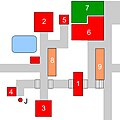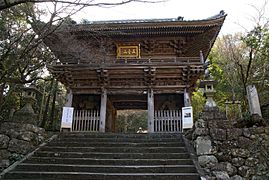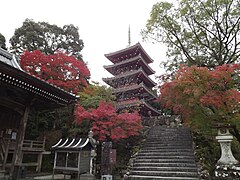Chikurin-ji (kochi)
The Chikurin-ji ( Japanese 竹林寺 ) in the city of Kōchi is a temple of the Shingon direction of Buddhism . It is the 31st temple on the Shikoku pilgrimage route .
history
According to tradition, Emperor Shōmu is said to have searched in a deep dream for a temple mount that resembled the Wutaishan ( 五台山 ) in China and found it near Kōchi. On this mountain, called Godaisan in Japanese, he had a temple built by the monk Gyōki . Later monk Kūkai is said to have promoted him, and finally he became an important prayer temple of the Yamanouchi clan ruling in Kōchi .
The attachment
You enter the complex through the temple gate, which is designed as a tower gate (楼門, Rō-mon; 1), i.e. a two-story gate with space for the two temple guards to the right and left of the passage. Then a winding cherry tree avenue leads up to the main hall ( 本 堂 Hondō ; 2), which is registered as an important cultural asset (hereinafter marked with ◎). It dates from the Bummei period (1469–1487), has a square floor plan of 13.7 × 13.7 m, has a wooden floor and a hip roof and is surrounded by a gallery. There the saint Monju ( 文殊 菩薩 Monju bosatsu ; ◎), accompanied by protectors ( 侍者 Jisha ), is venerated. The main hall is therefore also called Monju Hall ( 文殊 堂 Monju-dō ). The group is said to have been carved by Gyōki, it is the oldest of its kind in Japan.
Right next to the main hall is the pavilion dedicated to the saints, the Seitendō (聖 天堂; 5). Next to it, in front of the abbey, is the old guest house ( 客 殿 Kyakuden ; important cultural asset of the prefecture; 6), in which the daimyo and the higher samurai gathered before they went to the main hall for prayer. The temple garden (7) behind the abbey is registered at the national level as a beautiful view ( 国 名勝 Kuni meishō ). It is said to have been created by Muso Soseki .
In front of the main hall is the hall dedicated to the temple founder, the Daishidō ( 大師 堂 ; 3) from 1644, in which Kūkai is venerated. - If you go up the stairs at their side, you come to the five-story pagoda (五 重 塔, Gojū-no-tō; 4), which was built from the Hinoki wood in the style of the early Kamakura period . The temple originally had a three-story pagoda, but it collapsed in 1899 due to a typhoon. In 1980 the current pagoda was built. - The saint Jizō (J) in front of the pagoda is called "one-word jizō " ( 一 言 地 蔵Hitokoto jizō ) because a very short request is enough to be heard.
There is also a reception house for visitors (接待 所, Settaijo; 8) and the treasure house (宝物 館, Hōmotsu-kan; 9) on the temple grounds.
If you leave the temple through the west gate and walk up the path lined with mud walls, you come to a viewing platform in Godaisan Park. There is a bronze statue of the 27th Prime Minister Hamaguchi Osachi , who came from Kōchi.
Treasures of the temple
Buddhist sculptures are kept in the treasure house, all of which are registered as an important cultural asset of Japan. This includes an eleven-faced standing cannon carved from one piece of wood , which is 48.8 cm high and is something special with a wrap over the shoulder. It could be from the 10th to 11th centuries. - Other treasures include a standing Amida Buddha made of wood, 86.1 cm high, typical of the sculptor Jōchō (died 1057), the Shining Kings Daiitoku-myōō ( 大 威 徳 明王 ) and Aizen-myōō ( 愛 染 明王 ), and the kings of heaven Zōchō-ten ( 増 長 天 ) and Tamon-ten ( 多 聞 天 ).
photos
Remarks
- ↑ Sudhana ( 善財 童子 ), literally “rich child”, was an Indian youth who was looking for enlightenment. Here is a small bronze figure from 2014.
literature
- Kōchi-ken kotogakko kyoiku kenkyukai rekishi bukai (Ed.): Chikurin-ji . In: Kōchi-ken no rekishi sampo . Yamakawa Shuppan, 2006, ISBN 978-4-634-24639-3 , pp. 77 to 78.
- Oguri, Doei: Kukai. Shikoku hachijuhachi kosho no arukikata. Chukei no Bunko, 2011. ISBN 978-4-8061-4067-2 .
Web links
- Side of the temple (japanese)
← Previous Temple: Zenraku-ji | Chikurin-ji (kochi) | Next temple: Zenjibu-ji →
Coordinates: 33 ° 32 ′ 47.4 " N , 133 ° 34 ′ 35.4" E








